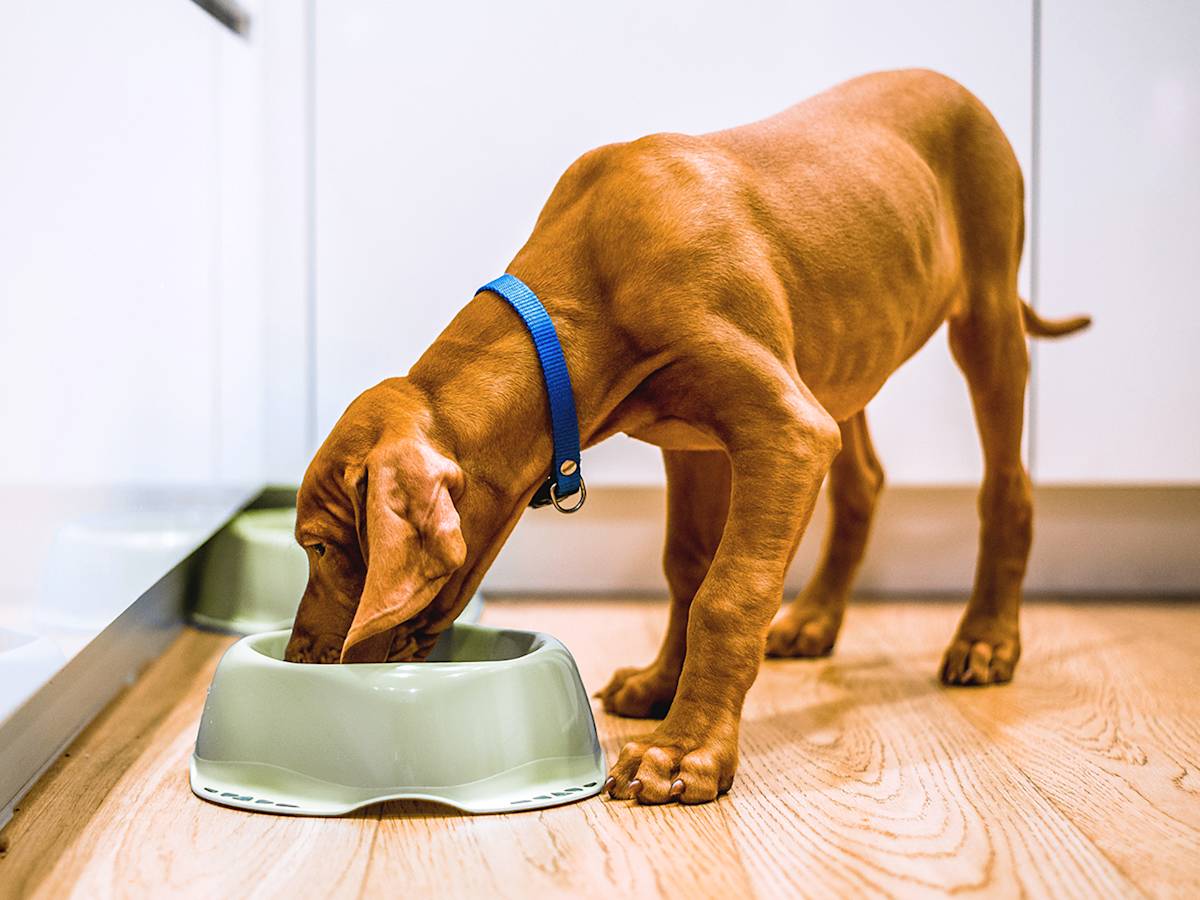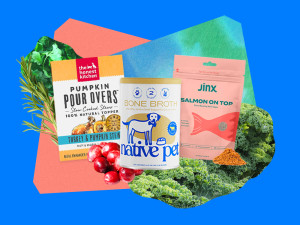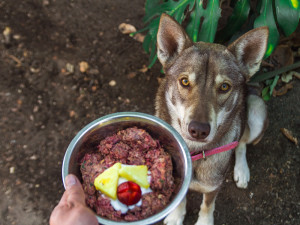A Digestible Guide to Healthy Dog Food for Your New Pup
How to pick the right grub for your dog when there are So. Many. Choices.
If you’ve ever felt paralyzed just trying to decide what to order for dinner, then you know that having too many choices is not always a good thing. Tacos, Thai, sushi. Picking a food for your new dog can feel equally overwhelming, especially when there’s a lot more to consider than kibble, wet, or raw. Pet store shelves are crowded with other features that may speak to you: Puppy stage — easy. Fresh — definitely. Human-grade — um, sure? Things can spiral quickly.
Don’t stress — we consulted three veterinarians to put together some pointers to help you make the right choice for your dog. Below are eight things to consider when you’re choosing your pup’s next meal.
1. Start with consistency.
Deciding on a dog food can feel like an urgent matter. Eating is, after all, rather important. But, depending on what information you can gather ahead of time, you may be able to ease into the selection process. Dr. Katie Lytle recommends asking the rescue, shelter, or foster family what food your dog has already been eating, if possible.
“Dogs go through a lot when transitioning to a new home, and making a diet change right away may be an additional source of stress. If you know your dog was doing well on a particular diet, you can stick with that initially and not feel like you have to rush to find the perfect food on day one.”
2. Choose dog food considering life stages and other factors.
First, zero in on food that is specifically formulated for your dog’s life stage or age range (i.e. ,puppy-stage, adult, senior), which most experts recommend given that your dog’s nutritional needs will vary a bit throughout their life. Then, think about what factors matter most to you. For example, if organic, all-natural, and artificial-free food is important to you, focus your search on companies that offer those options.
Keep in mind that — as is the case with human food — “natural” labels are not regulated by the FDA and can therefore still contain hormones, antibiotics, and GMOs. On that note, you may also recognize certifications such as “wild-caught,” “cage-free,” and “farm-raised.” Don’t stop there — consider sustainable dog food and recyclable packaging. Finally, you’ll want to consider things like budget and convenience: is the food widely available in retail stores or can it only be found in a specialty shop?
3. Label and ingredient lists on dog food
Smart as they are, dogs can’t read. According to Dr. Susannah Teran, the first thing to look for on any dog food label is a statement from the Association of American Feed Control Officials (AAFCO). “An AAFCO statement indicates that the food provides a complete-and-balanced diet — it’s a must for any food you choose. It will also indicate whether a food has met the appropriate nutritional level based on a lab analysis or an actual feeding trial. I recommend pet parents look for a food that has gone through a feeding trial, as that will give you a better indication of how a dog will respond to a given diet.”
The next area you want to assess is the actual ingredient list. This can be tricky because ingredients are listed on the label based on their pre-cooked weight. Although it often appeals to pet parents to see fresh meat as the first ingredient, that doesn’t necessarily mean it’s providing the best nutritional bang for the buck.
“Ingredients aren’t the same as nutrients,” Dr. Teran explains. “Ingredients are the raw materials that go into a diet, and nutrients are what actually get absorbed by a dog’s body. Different methods of processing will impact the nutrients your dog will get out of an ingredient. For example, before processing, chicken is about 70 percent water. Chicken meal, however, has had most of the water removed and is more nutrient-dense. So, even though chicken meal sounds less tempting to humans, it provides more protein than fresh chicken.”
4. Breed- and size-specific diets
You’ve probably seen dog-food labels specific to everything from teacup Yorkies to German Shepherds and thought, Is that necessary, really? These picks are less about a breed’s unique taste preferences than their genetic and physical needs. “Breed diets are designed to address known health issues or breed peculiarities,” Dr. Elizabeth Shines explains. “For instance, Labrador Retrievers often eat too quickly, which can lead to an upset stomach or cause them to gulp air [and risk a serious issue called bloat], so in Labrador-specific diets, the kibble shape is designed to get stuck around their teeth and slow down eating. Bulldogs are another example; this breed is known to be gassy, so diets typically have a special blend of fiber and are easy to digest, which tends to help decrease gas production.”
Size-specific diets aren’t quite as personalized, but they do have some advantages. “Large dogs need fewer calories per pound than small dogs and are also more likely to suffer from arthritis as they age, so large-breed diets often include ingredients that provide joint support,” Dr. Shines adds. “Small-breed diets are typically higher in calories and may be formulated to help address dental issues, which are common in our little friends.”
5. Kibble or wet dog food
As long as they have an appropriate AAFCO statement on the label, both dry kibble and wet food offer complete and balanced nutrition for dogs. Kibble is typically cheaper than canned food, can be more convenient to pack for a trip, and lends itself to use in interactive toys and puzzles. Wet food is, well, wetter than kibble.
That extra water content can be beneficial if you live in a hot climate where more hydration is helpful. Higher water content also typically means that, compared to kibble, your dog can eat a larger portion of food while still staying within their daily calorie range. That potentially leaves them feeling fuller and more satisfied after a meal. You can always combine the best of both worlds by adding a dollop of wet food to dry kibble. You do you.
6. Raw and dehydrated dog food
Raw diets are popular with pet parents who feel it more closely mimics how dogs’ ancestors, wolves, eat, and are made up of about 70 percent muscle meat, 10 percent organ meat, 10 percent edible bone, seven percent vegetables, and three percent seeds, nuts, and fruit. Most raw dog food diets on the market are prepared with pet parents in mind and are packaged in a user-friendly way — typically nuggets resembling burger patties that you store in the freezer, then refrigerate/defrost the correct portion overnight.
If you choose to feed your dog a raw diet, you may notice more regular poops and less gas because it’s digested in a fraction of the time. Picky eaters can’t complain about palatability and will wolf it down (pun intended), while dogs with allergies will benefit from the limited ingredients and lack of preservatives. Freeze-dried foods boast the same benefits detailed above, but rather than defrosting raw meat, you’ll need to mix in warm water to soften the dehydrated food. Freeze-dried food has a long shelf life due to its low moisture content and travels well, too.
7. Human-grade dog food
The ingredients in human-grade dog food are sourced in a manner to meet the same standards as foods fit for human consumption. These meals are minimally processed and still nutritionally balanced to meet your dog’s dietary needs. Some brands even offer subscriptions and customize meals (think: Blue Apron for your pup). As always speak with your vet first before making any switches to your dog’s diet, including to human-grade foods.
8. Supplements and other specific needs
Though a lot goes into choosing a food for your dog, landing on a product isn’t actually the final step in the process. You’ll want to assess if your pup is responding well to the food. Dr. Shines says: “Signs that your dog’s diet is working well include a shiny coat, healthy skin that isn’t dry or flaky, BMs two or three times a day, and normal poop — it should be formed, meaning not runny and not overly hard.” If any of these factors don’t seem quite right, consider slowly transitioning your dog to a new food or talk to your vet.
As you get to know your new dog, you may also discover new dietary needs. Dogs with allergies, skin issues, or heart conditions can benefit from dog foods supplemented with omega-3 and omega-6 fatty acids for skin/coat health, such as flaxseed, fish, and sunflower oils. If your pup is packing on the pounds despite getting lots of exercise, your vet may recommend a “weight-control” dog food. And if you find that your dog has a sensitive stomach, a diet formulated for digestive support might help with that.
Even if your dog is thriving, it couldn’t hurt to mix up formulas and proteins every now and then to make things more interesting (if the change doesn’t cause an upset stomach). Thankfully, dogs don’t need as much variety as people do.
Disclaimer alert: This article is here to share information. But, much like pineapple on pizza, the topic may be controversial. Meaning, not all vets or pet professionals agree. Because every pet is a unique weirdo with specific needs. So, don’t take this as fact or medical advice. Talk things over with your vet when making decisions, and use your best judgment (about both your pet’s health and pizza toppings).












